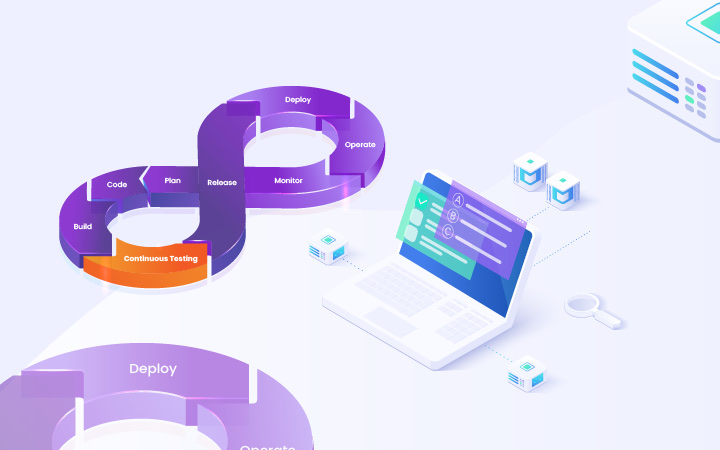Application Delivery through continuous Integration and continuous deployment (CI/CD) pipelines has become increasingly popular in recent years. With an efficient CI/CD pipeline, enterprises are able to deliver applications and scale them rapidly with efficiency. The principles of CI/CD have evolved over time and today have become the backbone of modern software development. But building this efficient end-to-end CI/CD pipeline is not an easy feat. It requires tons of planning, efficient implementation, and excellent team collaboration. Even after all these efforts, the resulting CI/CD pipeline is not as reliable and swift as anticipated for most organizations. Today, only 11% of all organizations consider their CI/CD pipeline to be reliable enough to build and deploy applications rapidly and efficiently.
Considering that the CI/CD principles have been growing and evolving for over 10 years now, this number is shockingly low. So, what are we all missing?
The major roadblock for all application delivery lifecycles is quality testing. Organizations today look at application testing as a siloed step in their CI/CD pipeline. This leads to quality assurance becoming a bottleneck in several aspects.
Challenges of Application Testing in Your CI/CD Pipeline
- Increased Complexity
No enterprise application today is a standalone entity. Every application is a business process enabler, and all apps need to function efficiently and in sync to ensure business continuity. The high focus on applications enabling end-to-end business flow has led to modern software applications becoming more and more complex, making it harder to identify and fix issues. These complexities often result from integration with multiple platforms, data sources, and cloud-based environments. Applications this advanced have rendered traditional manual testing approaches impractical and unsustainable. - Time Constraints
Software development teams are under increasing pressure to deliver high-quality software quickly. The traditional approach of manual testing is time-consuming and often results in delays in the software development lifecycle. There is a need to automate the testing process to speed up the delivery process while ensuring software quality. - Cost
Manual testing is not only time-consuming but also expensive. Hiring a team of testers to manually test software is costly, and the team may miss critical bugs that could cause more expenses down the line. Investing in automated testing tools can save costs and improve software quality. - Lack of Test Coverage
In traditional testing, testers can only test a limited number of scenarios, resulting in inadequate test coverage. This lack of test coverage may result in defects being undetected, causing significant problems after the software is deployed.
When your application is in the CI/CD pipeline while testing is a separate siloed process, the end quality of the application gets affected. Testing today can no longer be a siloed pre-deployment step if you need an efficient CI/CD process that has no bottlenecks. Instead, what if you could implement continuous testing within your CI/CD pipeline?
Continuous Testing – A New Hype Word or Something Important?
Continuous testing is an approach to software testing that emphasizes the need for automated testing throughout the software development lifecycle. Rather than waiting until the end of development to test the software, continuous testing involves running automated tests continuously throughout the process. This ensures that any defects or issues are caught and resolved early on before they can cause problems down the line.
Continuous testing involves the use of automated testing tools that can run tests automatically as part of the software development process. This can include unit tests, integration tests, regression tests, and more. These tests are typically run in an automated testing environment that can simulate real-world conditions and test the software under a variety of scenarios.
How Continuous Testing Helps Combat Quality Assurance Challenges
- Increased Test Coverage: Continuous testing allows for a higher level of test coverage as automated tests can be run more frequently and in different environments. With increased test coverage, developers can identify and resolve defects earlier in the software development process.
- Faster Time to Market: Continuous testing allows developers to identify defects quickly, resulting in a faster time to market. Automated testing tools can be used to test the software continuously, which allows for quicker detection and resolution of defects.
- Cost Savings: Automated testing tools can save costs by reducing the need for manual testing. Automated testing is more efficient, less prone to errors, and can run continuously. This reduces the cost of testing while improving software quality.
- Early Defect Detection: Continuous testing can identify defects early in the software development process. With early defect detection, developers can fix problems before they become more significant and more costly to resolve.
Continuous Testing in the CI/CD Pipeline – The Shift From CI/CD to CI/CT/CD
Continuous testing plays a critical role in the CI/CD pipeline. The goal of CI/CD is to create a more efficient and streamlined development process that can quickly deliver high-quality software. When the needs for software development evolve with advancing technology, CI/CD evolves as well.
CI/CT/CD stands for Continuous Integration/Continuous Testing/Continuous Delivery, and it is an approach to software development that emphasizes automation and collaboration.
Continuous testing is a key component of the CI/CD pipeline because it ensures that software is thoroughly tested at every stage of the development process. This helps to identify defects and issues early on, which can reduce the need for rework and ensure that the software is of higher quality. Continuous testing also helps to ensure that software is delivered to customers quickly and efficiently, as part of the continuous delivery process.
Implementing Continuous Testing for Your Business Applications
Implementing continuous testing for your business applications can be a daunting task, but it is essential for ensuring that your software is of high quality and delivered quickly and efficiently. Here are some steps you can take to implement continuous testing for your business applications:
- Choose the Right Tools: The first step in implementing continuous testing is to choose the right tools for the job. There are many different automated testing tools available, so it’s essential to choose the ones that are best suited for your specific needs.
- Define Your Test Strategy: Once you have your testing tools in place, it’s essential to define your test strategy. This involves identifying the types of tests you need to run and when you need to run them.
- Implement Test Automation: With your test strategy in place, it’s time to implement test automation. This involves creating automated tests that can be run as part of the software development process.
- Integrate Testing into Your CI/CD Pipeline: Once you have your automated tests in place, you need to integrate them into your CI/CD pipeline. This involves running the tests automatically at every stage of the development process, from development to testing to deployment.
- Monitor and Analyze Test Results: Continuous testing requires ongoing monitoring and analysis of test results. This involves tracking the performance of your tests and identifying any issues or defects that are discovered during testing.
- Continuously Improve Your Testing: Continuous testing is an ongoing process that requires continuous improvement. As you gain more experience with automated testing, you should continuously refine your testing strategy and improve your automated tests to ensure that they are effective at catching defects and issues.
Wrapping Up
Application quality assurance has always been a challenge for software development teams. With the increasing complexity of software applications and the need for rapid development and delivery, ensuring the quality of software has become more important than ever.
Continuous testing is a critical component of modern software development. It ensures that software is thoroughly tested at every stage of the development process, reduces the risk of defects and issues, and enables faster time to market. By implementing continuous testing for your business applications, you can ensure that your software is of the highest quality and delivered quickly and efficiently to your customers. Remember to choose the right tools, define your test strategy, implement test automation, integrate testing into your CI/CD pipeline, monitor and analyze test results, and continuously improve your testing strategy. With these steps in place, you can reap the many benefits of continuous testing and take your software development process to the next level.

